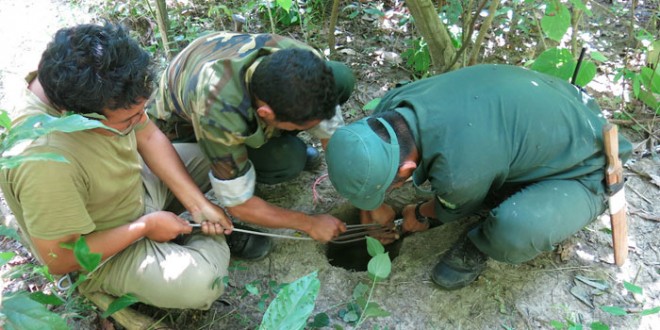Collaring The Manas Tigers
Kuensel: The maiden tiger radio collar programme began at the Royal Manas National Park (RMNP) in Panbang, Zhemgang since November 4. Although the Ugyen Wangchuck Institute for Conservation and Enviornment (UWICE) has radio collared Black-necked Cranes, Griffons, Takins and pheasants, this is the first time that Bhutanese biologist and foresters have led the programme without foreign assistance.
UWICE is leading the programme with support from Wildlife Conservation Division and Jigme Singye Wangchuck National Park and RMNP. The team is trying to radio collar tigers in lower foothills of Manas park range office located about 10 kilometers from Panbang.
Customized foothold snare made in Thailand were set up in four different locations in Manas park arrange office. The names of the specific location of the traps are omitted in the report on request of conversationalists to prevent giving the position of tigers to poachers.
“We are placing traps at most probable locations”, UWICE’s tiger biologist Tshering Tempa said.
The improvised spring enabled snare is made from an arrow sized steel cable tied with a noose on its tip. The snare is set up in hole in the ground with its noose open with a tong like trigger concealed under soil and leaves. When a tiger passes through its trial, the moment it steps on the noose, a trigger is set off and its leg would be caught.
“It has been proven safe and even if the tigers are caught the snare poses no risk”, Tshering Tempa said, adding that the traps, which were imported from Thailand has been customized and tested successfully on tigers in Thailand.
UWICE director Nawang Norbu said that no injury would be caused even if humans get trapped in it. “Safety has been confirmed because the biologists have practically ensnared their hands”, he said.
The Bhutanese team also underwent a 10-day extensive hands-on training at the Khaonangrum regional tiger research center in Huni Kha Khaeng wildlife sanctuary in Thailand recently. The team learnt how to set up traps, immobilization and safe handling of tiger.
“When a tiger is ensnared, it will be brought down with a tranquilized dart”, Tshering Tempa said.
The tiger’s body size, length, weight and canine length will be noted after it is anaesthetized. Other details such as size of the balls and status of the nipples will also be noted. Besides, the tiger’s pulse and respiration rate would be noted in every five minutes to ensure the animal is safe.
The whole process is expected to take about 45 minutes. Once collared the tiger would be released into the wild safely.
“The objective is to study the movement pattern of the tiger, ecology in the mountainous landscape besides minimizing poaching incidents”, Tshering Tempa said, adding that the radio collar is also to help address the human-wildlife conflict.
The information gathered from radio collar would also enable researchers calibrate and validate the recent tiger population estimate of 103 as well as for the future. The data from the radio collar more importantly would be a revelation for those international skeptics who still doubt Bhutan of being a tiger shtronghold.
“This is a unique chance to prove otherwise”, Nawang Norbu said.
Tshering Tempa said that the Royal Bengal tiger is found mostly in the plains.
“When it comes to tiger only counts are available but in general tiger biology still has only sporadic information”, Tshering Tempa said.
Similar radio collaring programmes would follow in different parks on tigers and other wildcats such as leopard. Bhutan Foundation funds the programme.
The programme was initiated to commemorate the 60th birth anniversary of the Fourth Druk Gyalpo





